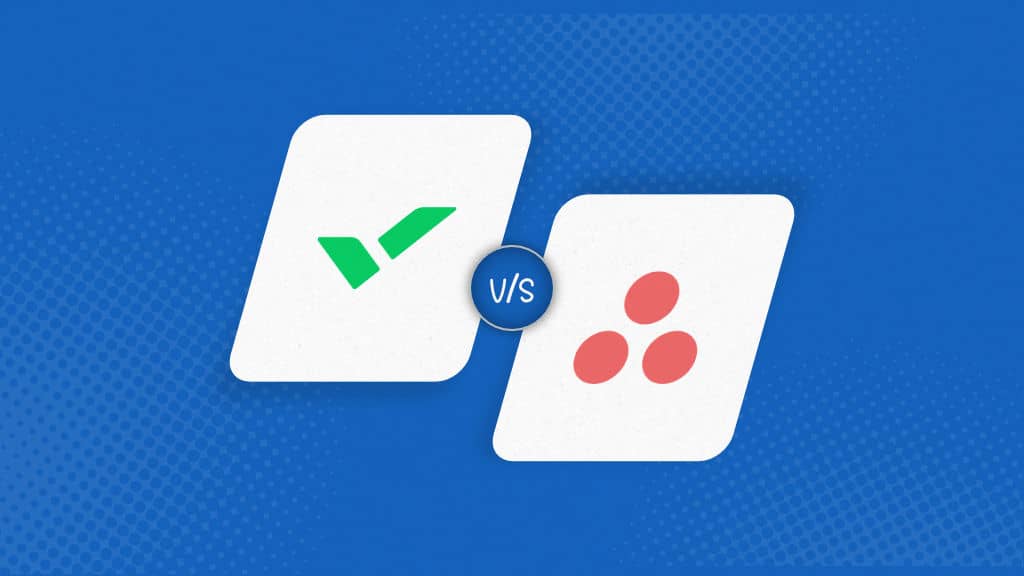If you’re deciding between Wrike and Asana, the best choice depends on how your team works – not just what features you see on the surface.
- Choose Wrike if you lead a large, structured organization with multiple teams or clients and need detailed reporting, layered permissions, and advanced workflow control. It’s built for visibility and governance across complex operations.
- Choose Asana if your team is small to mid-sized, fast-moving, and values quick setup, collaboration, and visual simplicity. It’s ideal for marketing, creative, or startup environments where priorities change often.
- Choose ProofHub if you want the simplicity of Asana with the structure and control of Wrike, without the complexity or per-user pricing. It’s a unified workspace that scales effortlessly across teams of any size, from startups to enterprises.
In short, Wrike is for structure, Asana is for speed, and ProofHub bridges both worlds with balance and adaptability. Those are the headline differences, but understanding which tool truly fits your team comes from seeing how they perform in real workflows. Below, you’ll find a detailed comparison of Wrike, Asana, and ProofHub – their strengths, trade-offs, and the kind of teams they empower best.
You’ll see how each tool approaches project management from a distinct philosophy: Wrike through precision, control, and enterprise-grade visibility; Asana through clarity, collaboration, and speed; and ProofHub through an integrated middle path that emphasizes both simplicity and structure.
By the end, you’ll have a clear picture of which platform aligns best with your team’s workflow. Let’s begin by understanding how Wrike and Asana are built to organize work – and what that means for the way your team plans, executes, and collaborates day to day.
What is Wrike?
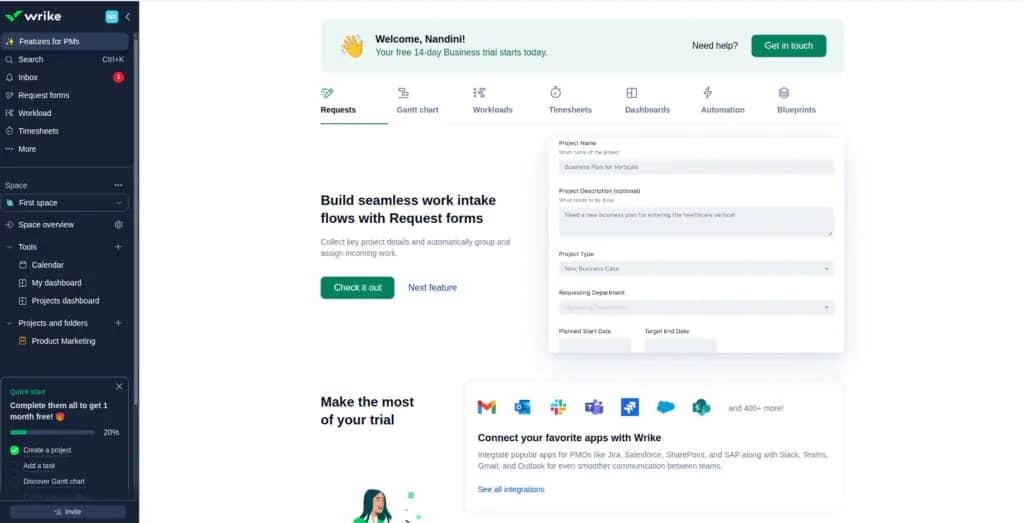
Wrike is a cloud-based project and work management tool that offers teams a variety of tools to plan, manage, and track their work. It is designed to give leaders visibility into how projects move, where resources are spent, and what’s slowing teams down.
Andrew Filev launched Wrike in 2006 to help teams move beyond complicated spreadsheets and endless email chains into a unified system for managing work. Over the years, Wrike has evolved from a modest collaboration platform into a comprehensive work management solution used by enterprises, agencies, and cross-functional teams across the globe.
Wrike is particularly famous for its structure and scalability. Instead of merely tracking tasks, Wrike helps organizations plan, execute, and measure work with controlled, data-driven management, making it especially appealing to large teams that manage multiple projects and dependencies simultaneously.
What distinguishes Wrike from other project management tools is its adaptability. Teams can shape the platform around their existing processes. Whether they’re running agile marketing campaigns or coordinating enterprise-level programs, Wrike doesn’t force you into rigid templates. Managers gain the ability to model real-world workflows digitally, aligning day-to-day execution with strategic goals.
In recent years, Wrike has continued to refine its platform for remote, hybrid, and distributed teams. Its growing focus on automation, analytics, and collaboration intelligence reflects a broader shift in how organizations want to manage performance and productivity.
Wrike comes with significant sophistication and a steeper learning curve; however, it’s a good choice for teams that value control and data-based oversight over simplicity.
What is Asana?
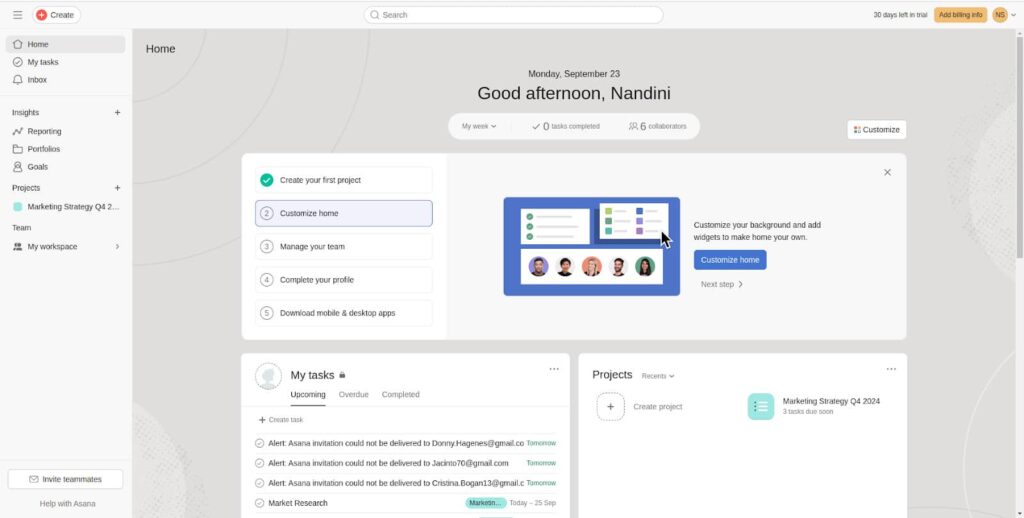
Asana is an online project and task management platform that helps teams to stay organized and aligned with their work. Its clean interface and structured task hierarchy make it easy for teams to plan projects, assign responsibilities, and track progress without needing formal project management training.
Launched in 2008 by Facebook co-founder Dustin Moskovitz and engineer Justin Rosenstein, Asana started as an internal coordination tool, which later grew into one of the most popular task management software, known for its intuitive design and user-first philosophy.
Where many enterprise tools focus on complexity, Asana stands out for its clarity and approachability. This accessibility has made Asana a preferred tool among marketing teams, startups, and small to mid-sized organizations seeking a system that just works.
Over time, Asana has evolved into more of a collaboration hub built around visibility and accountability. Managers can see what’s being worked on, identify blockers early, and ensure everyone’s priorities align with organizational goals. This balance between usability and structure makes Asana appealing to leaders who value transparency and progress without the friction of steep learning curves or heavy setup.
Beneath its simplicity, however, Asana’s features may start to feel restrictive when scaling the use across multiple users. The overall cost may also become restrictive with growing teams. Additionally, while managing a project at a large scale, Asana might need dedicated administrative oversight to keep working without collapsing.
What is ProofHub?
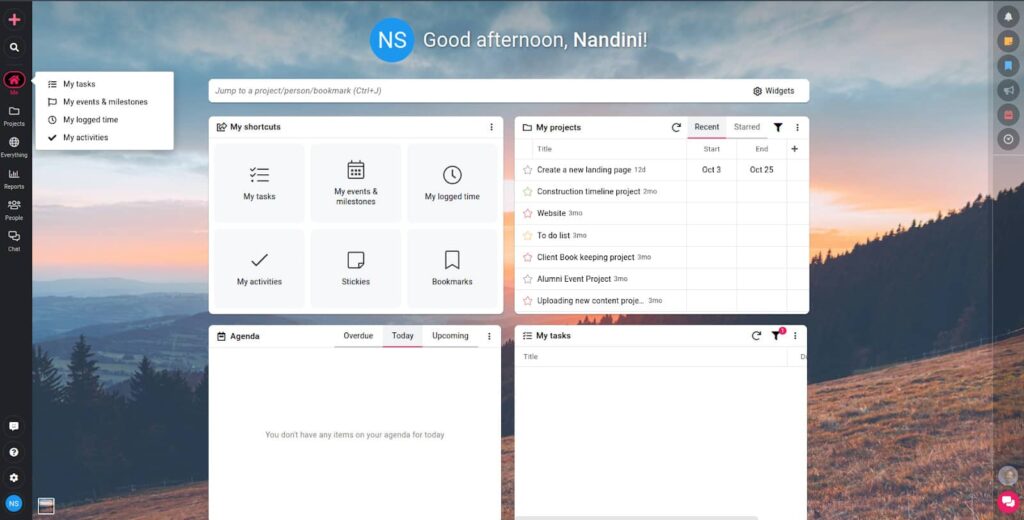
ProofHub is an all-in-one project management and team collaboration platform built for teams of any size. It helps you plan, organize, track, and manage projects of varying scope and complexity – all from one place. By centralizing your tasks, files, and communication, ProofHub keeps context intact and prevents information from scattering across multiple tools.
Combining the structure of Wrike with the simplicity and flexibility of Asana, ProofHub offers a balanced approach to managing projects and teams. Founded in 2011 by Sandeep Kashyap, it began as a proofing tool for designers and developers and has since grown into a complete project management solution.
Over the years, ProofHub has grown its feature portfolio to support multiple project management methodologies, ranging from Waterfall to Agile and hybrid models. Its biggest strength lies in handling projects of any scale without adding administrative overhead or requiring extensive training. Additionally, its flat, no-per-user pricing allows organizations to bring everyone on board – from core teams to external collaborators – without worrying about rising costs as projects grow. This pricing structure makes ProofHub predictable and accessible, especially for growing teams managing several parallel projects. With granular access control, information stays organized and secure as teams expand. Project managers can define who sees what, ensuring sensitive data remains protected while maintaining transparency where it’s needed. This level of control keeps large, cross-functional projects aligned without the chaos that often comes with growth.
Wrike vs Asana: Quick comparison table
Choosing between Wrike and Asana often comes down to what level of structure, control, or simplicity your teams need. The table below summarizes their key differences in pricing, usability, and functionality to help you make an informed first impression before exploring each area in depth.
 |  |  |
|---|---|---|
| Overview | ||
|
|
|
| Pricing model | ||
|
|
|
| Ease of use | ||
|
|
|
| Project views | ||
|
|
|
| Collaboration | ||
|
|
|
| Resource & workload management | ||
|
|
|
| Reporting & Analytics | ||
|
|
|
| Integrations | ||
|
|
|
| Automation & AI | ||
|
|
|
| Customization & Scalability | ||
|
|
|
| Support & learning curve | ||
|
|
|
Both tools deliver strong project management foundations, but Wrike leans toward enterprise control and configurability, while Asana prioritizes ease, accessibility, and speed.
Wrike vs Asana: Detailed comparison
Project management capabilities
The foundation of any project management tool lies in how well it helps teams plan, organize, and monitor work from start to finish. Whether it’s tracking milestones, coordinating cross-functional projects, or visualizing dependencies, the right platform should give managers both clarity and control, without burdening team members with complexity.
Wrike project management capabilities
Wrike takes a methodical and structured approach to project management. It allows teams to break down projects into actionable plans with defined hierarchies, dependencies, and timelines. Managers can visualize progress through custom dashboards and detailed project views, ensuring that nothing slips through the cracks.
Wrike’s portfolio-level visibility allows leaders to oversee multiple projects at once, manage cross-team dependencies, and make resource adjustments in real time. This depth of control is particularly valuable for organizations managing complex, multi-departmental initiatives where coordination and accountability are key.
Key project management features in Wrike include:
- Gantt charts: Interactive timelines to visualize dependencies and track project progress.
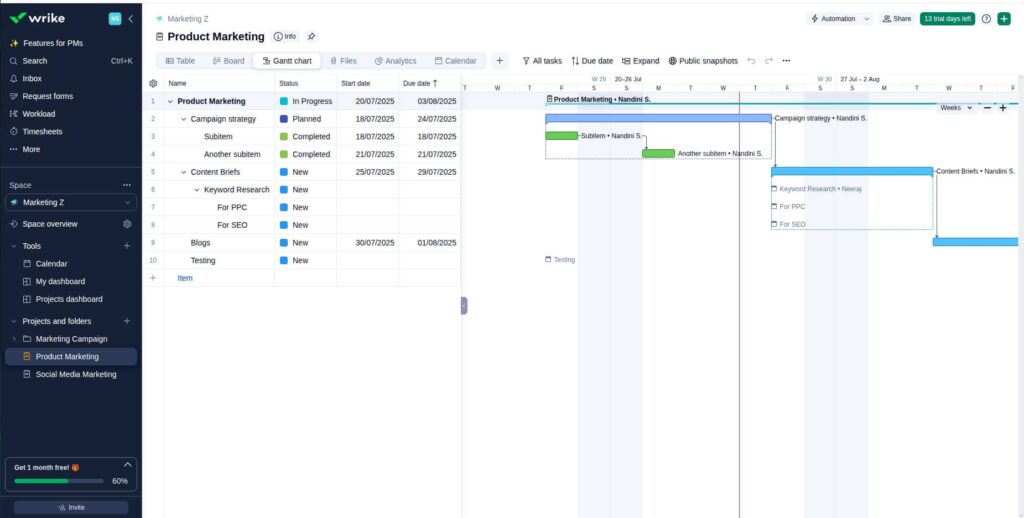
- Custom dashboards: Real-time performance views showing KPIs, workloads, and milestones.
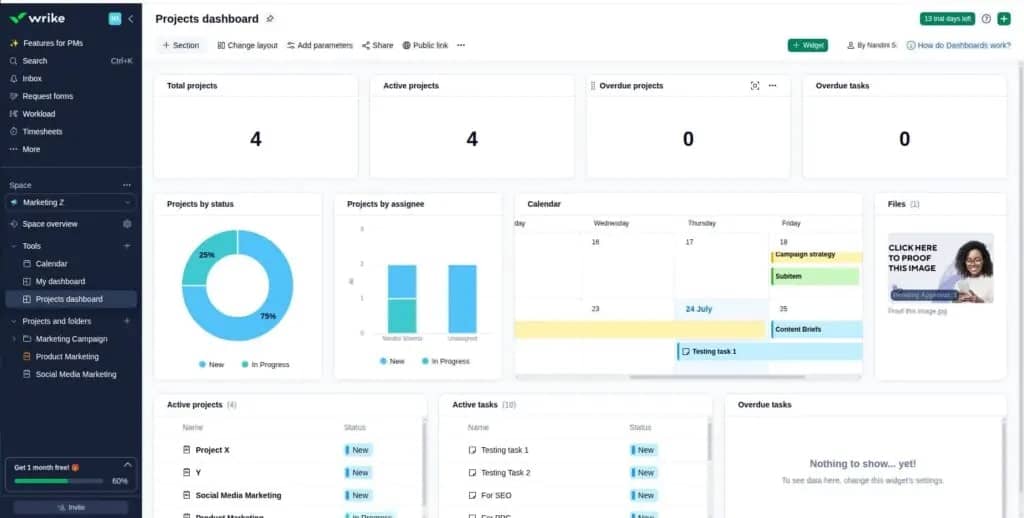
- Portfolio management: Centralized control for monitoring multiple projects and resource allocations.
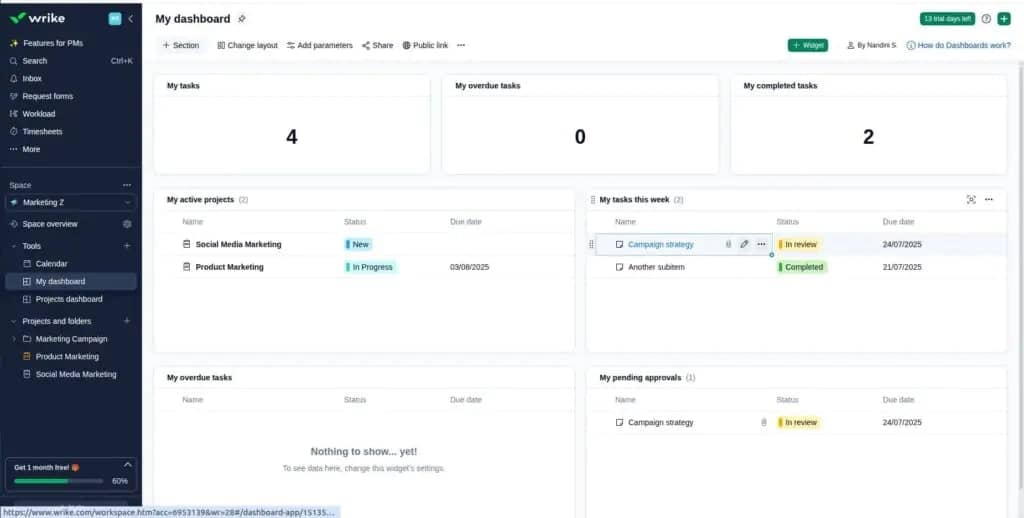
- Blueprints: Predefined setups for recurring workflows such as marketing campaigns or client projects.
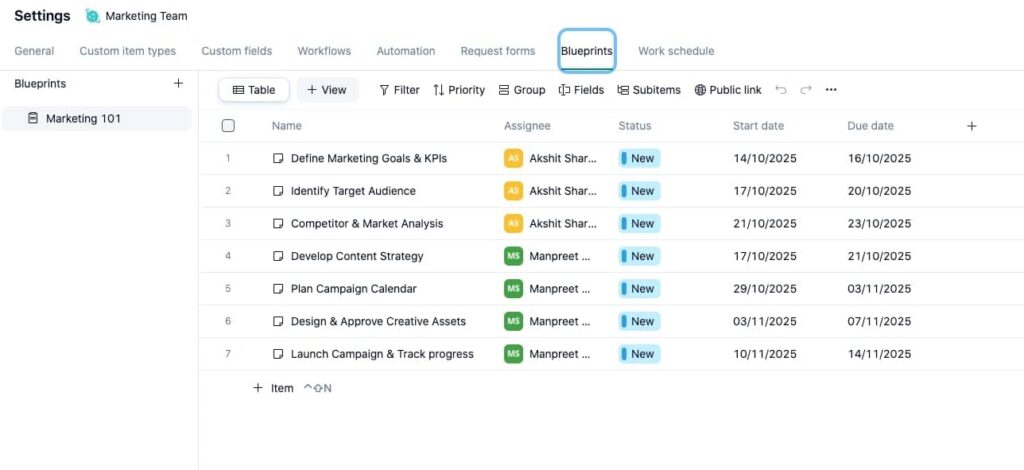
- Dependency tracking: Visual linking between tasks to ensure smooth sequencing and prevent bottlenecks.
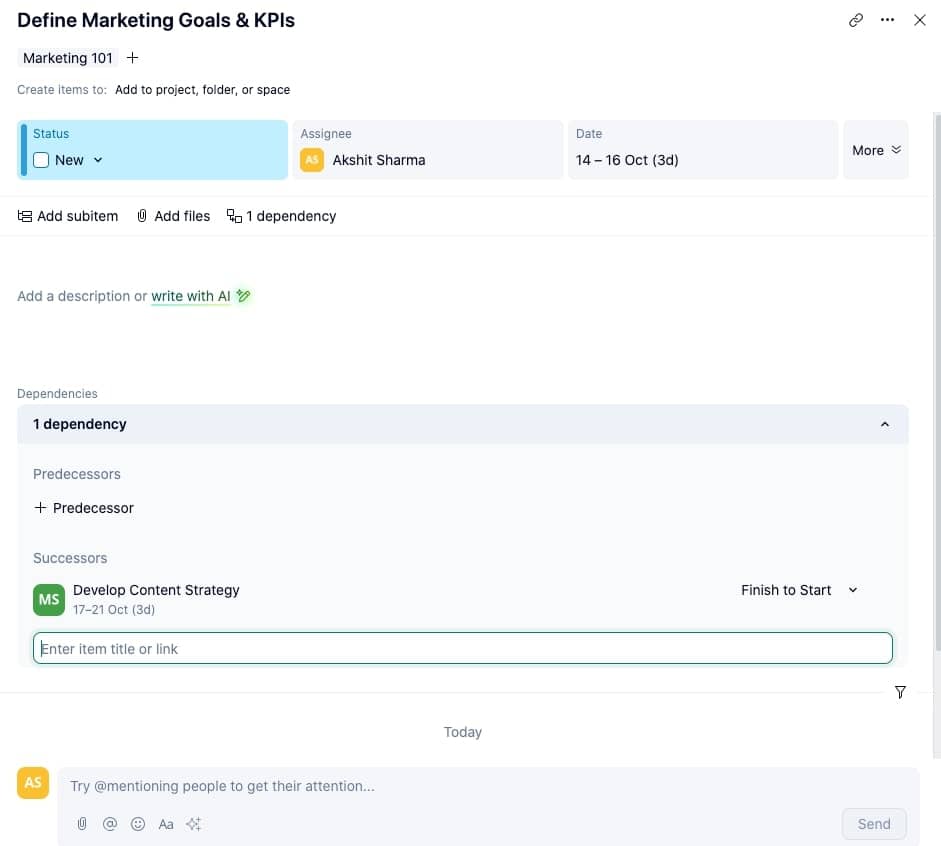
- Time tracking: Built-in timers and logs for monitoring effort and productivity across teams.
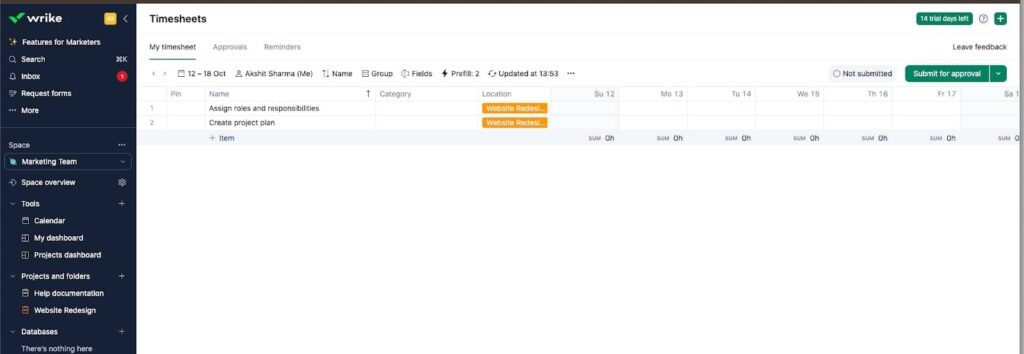
- Request forms: Custom intake forms that convert submissions into actionable tasks or projects.
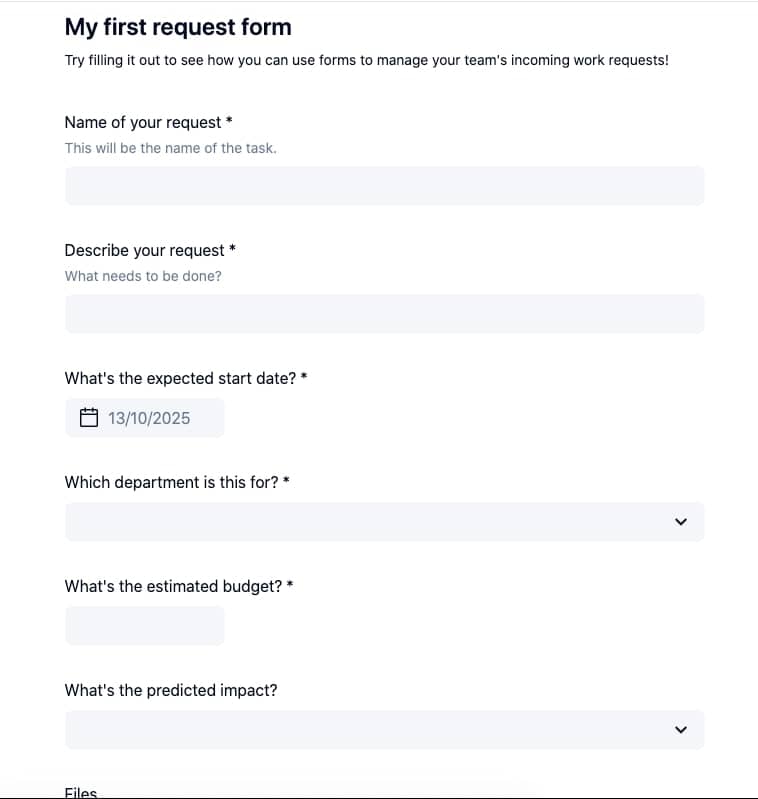
While Wrike’s sophistication allows for unmatched control, its detailed configuration can feel complex at first – especially for teams new to structured project management.
Asana project management capabilities
Asana focuses on making project management feel intuitive rather than procedural. Projects can be set up using ready-made templates or custom workflows that adapt easily to team preferences. The interface emphasizes visibility and collaboration. Team members can toggle between list, board, timeline, and calendar views depending on how they like to work.
Unlike Wrike, Asana minimizes structural overhead. It favors clarity and flow over deep control, allowing managers to keep everyone aligned without complex setup or steep learning curves. This makes Asana especially appealing to marketing, creative, and startup teams that prioritize flexibility and speed over formal governance.
Key project management features in Asana include:
- Multiple views: Several visualization options for task tracking and planning, including lists, boards, and timeline views.
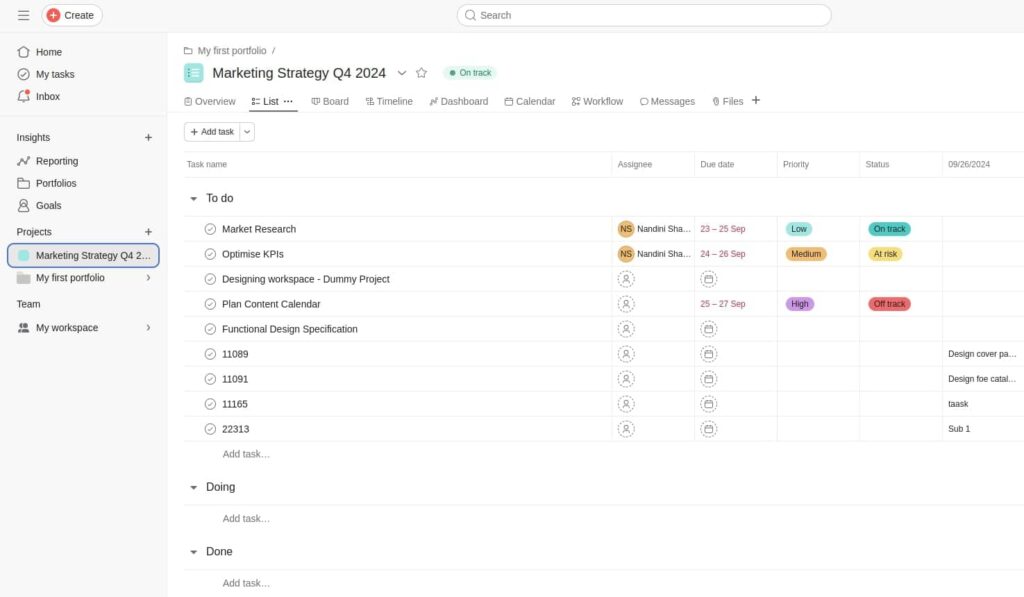
- Goals and portfolios: Alignment tools for linking tasks to higher-level organizational objectives.
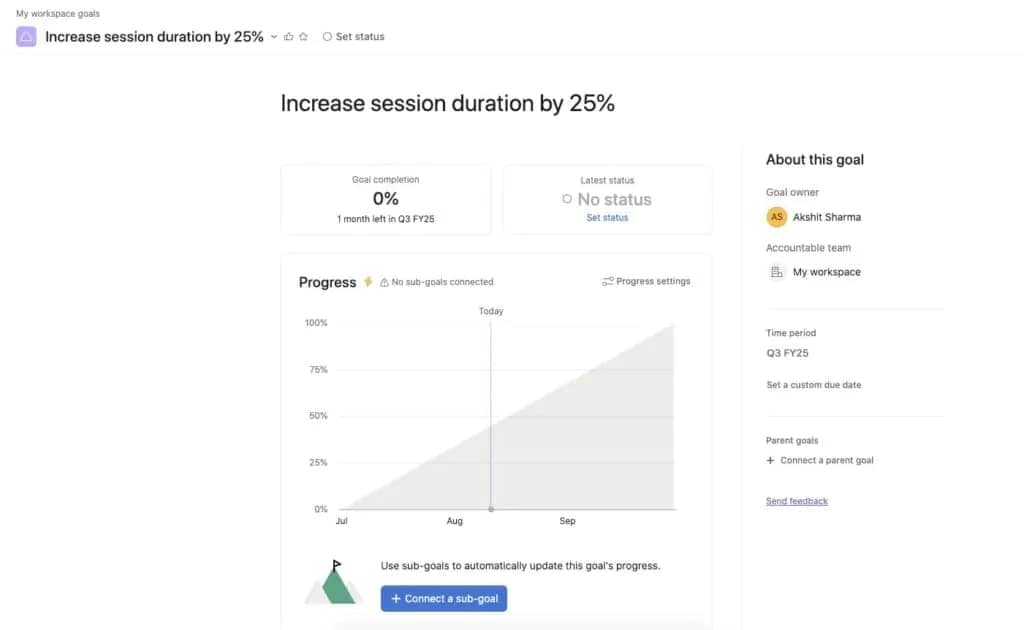
- Project templates: Ready-to-use setups for marketing campaigns, product launches, and sprint cycles.
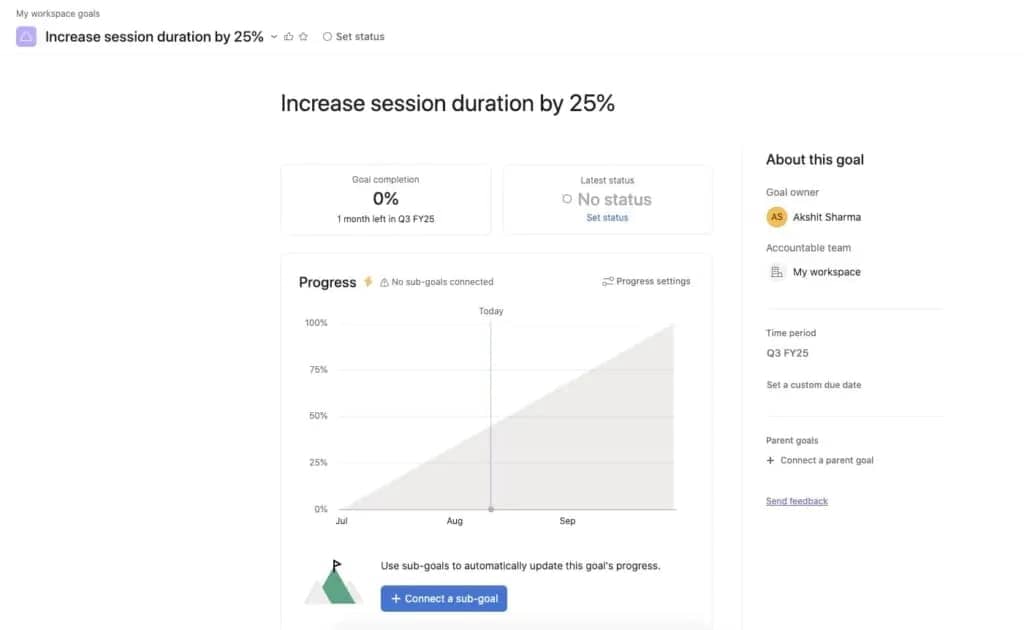
- Rules and automation: Simple triggers that streamline repetitive administrative tasks.
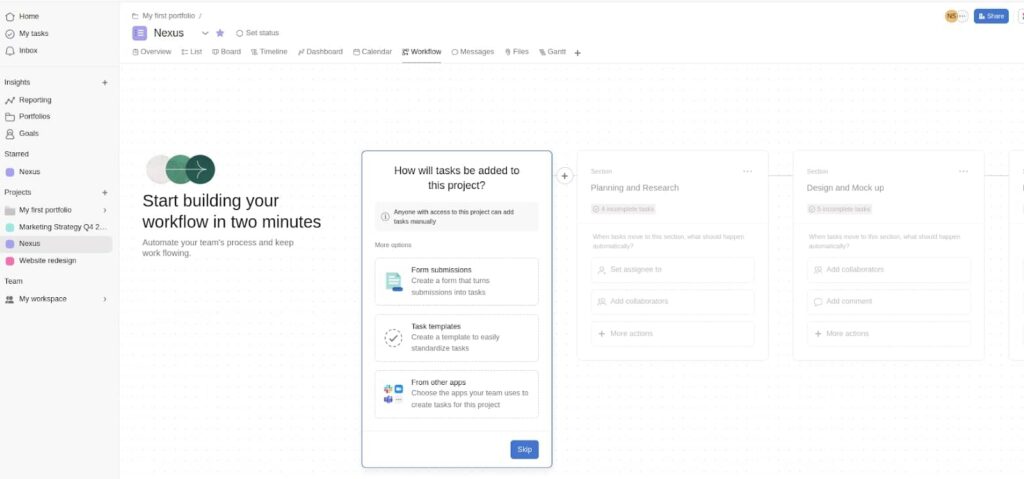
- Calendar view: Scheduling tool that helps teams visualize deadlines and avoid overlaps.
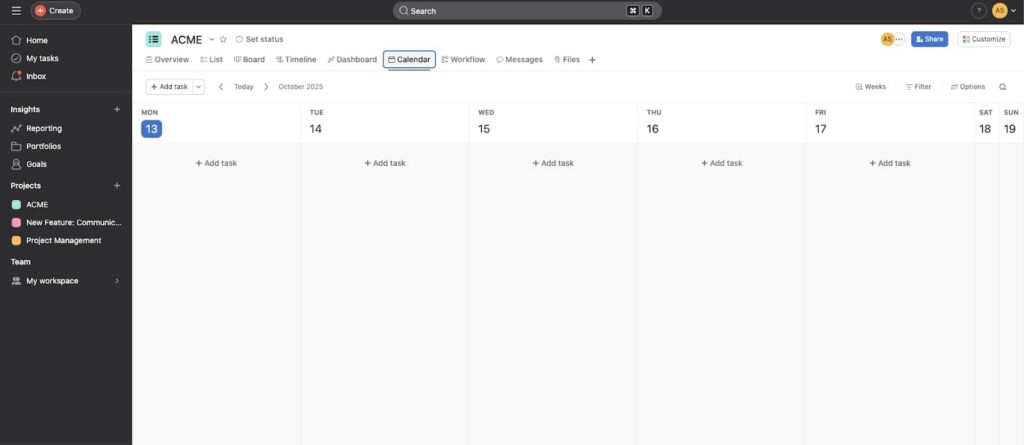
- Progress reporting: Lightweight dashboards to monitor overall project completion and updates.
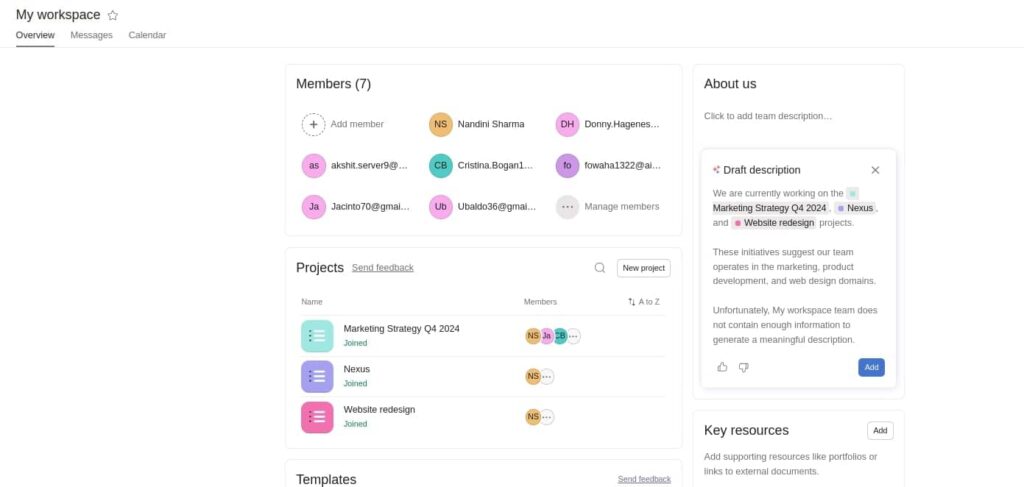
Asana’s design philosophy ensures that even non-technical users can manage projects confidently without feeling constrained by process-heavy structures.
ProofHub’s project management capabilities
ProofHub takes an all-in-one approach to project management – giving teams the clarity to plan, track, and deliver projects without relying on multiple disconnected tools. Its structure is intentionally designed to balance governance and flexibility, making it equally useful for teams managing linear workflows or iterative, cross-functional projects.
Unlike Wrike, which prioritizes enterprise-grade configurability, or Asana, which focuses on simplicity and speed, ProofHub brings both together. Every project can be customized with tasks, milestones, workflows, and reports that reflect how the team actually works – without complex setup or external plug-ins.
At its core, ProofHub helps teams move from fragmented execution to centralized visibility. Project managers can oversee progress at a glance, identify bottlenecks early, and ensure that day-to-day activities stay aligned with larger goals.
Key project management features in ProofHub include:
- Project categories: Create and manage multiple projects and organize them by grouping under different categories.
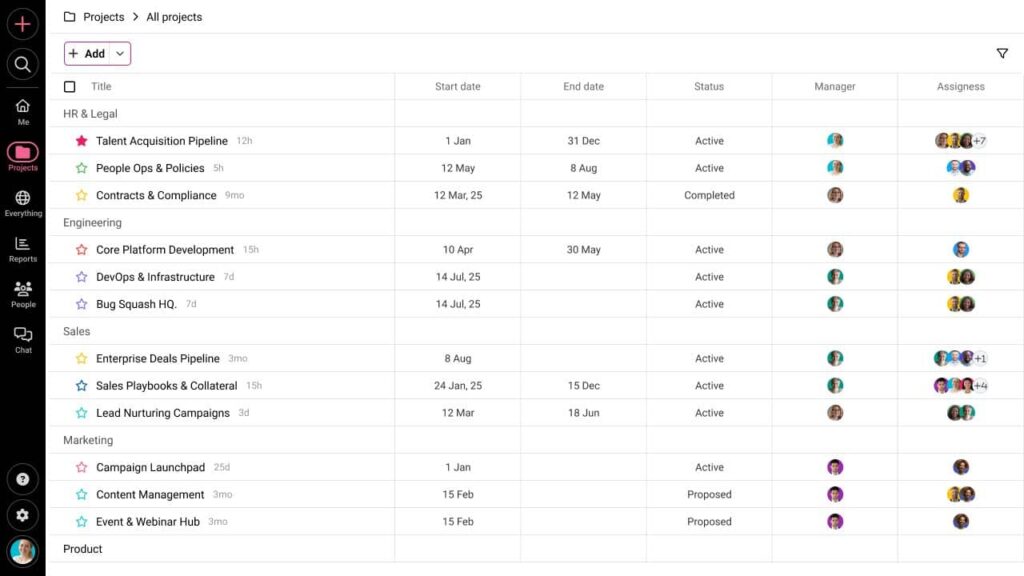
- Milestones: Define milestones, set dependencies, and break projects into tasks and subtasks to track progress with precision.
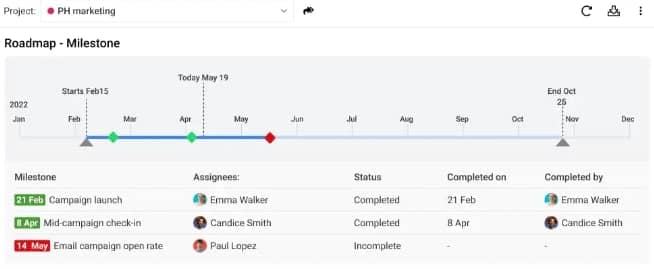
- Gantt charts: Interactive timelines let managers plan dependencies, shift priorities, and monitor deadlines visually.
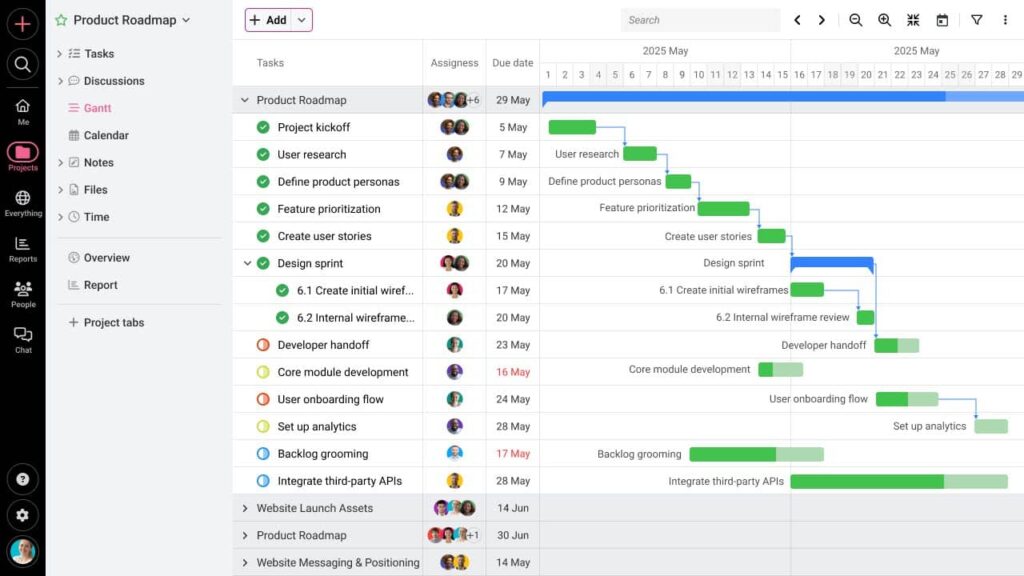
- Project templates: Quickly launch repeatable project structures for recurring initiatives like marketing campaigns, client deliveries, or product sprints.
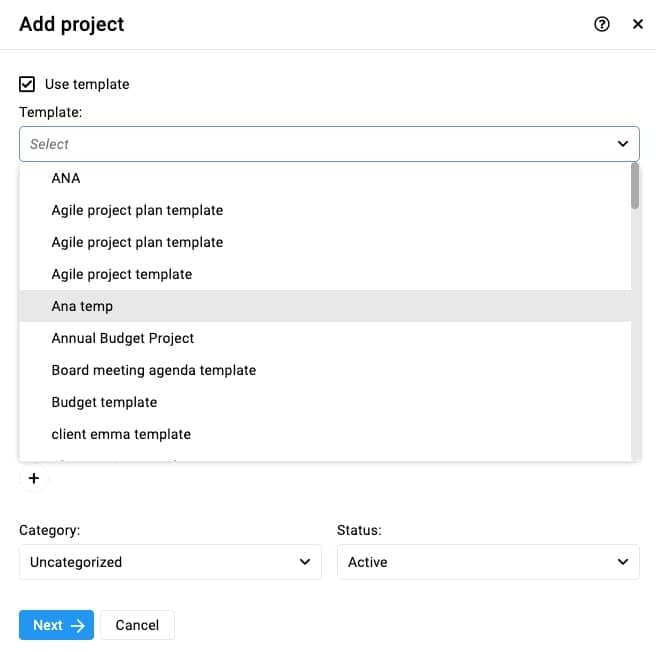
- Time tracking & timesheets: Built-in timers and manual logs capture actual effort, making it easier to analyze productivity and plan future workloads.
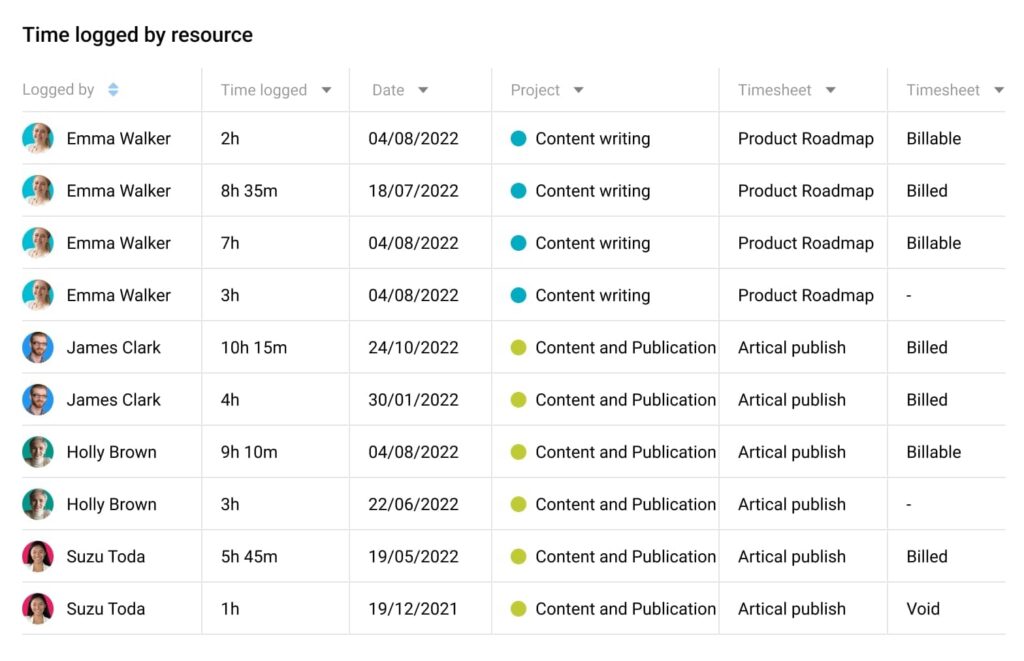
- Progress reports: Generate reports for projects, tasks, or users to see performance metrics and identify where work is slowing down.
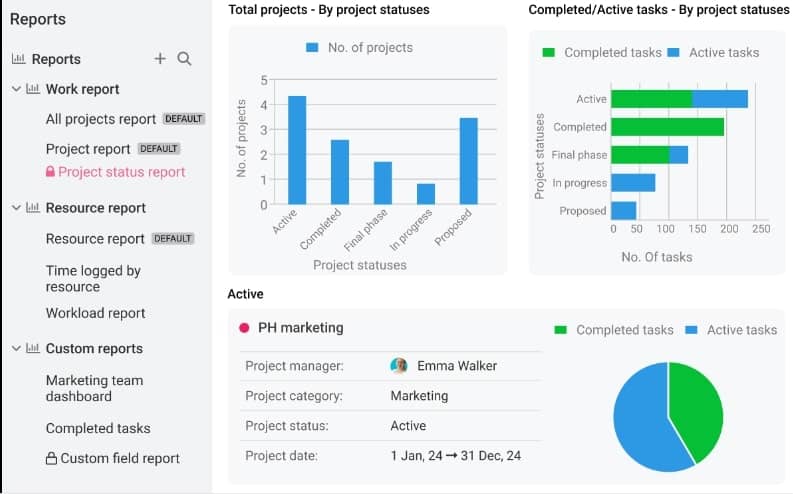
- Calendar view: Unified visibility of tasks, milestones, and events helps teams stay on top of deadlines and cross-team dependencies.
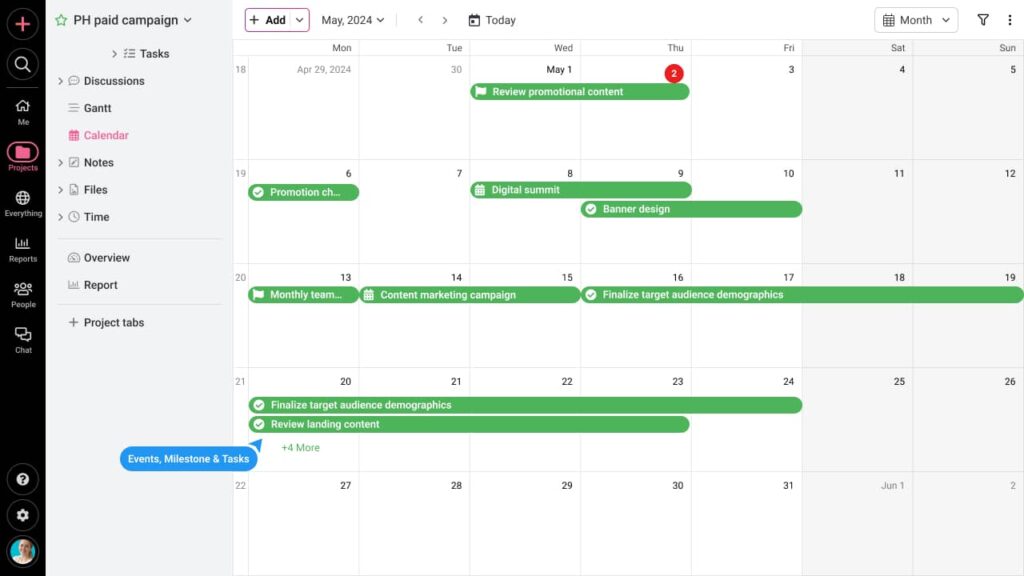
ProofHub’s project management strength lies in its structure without rigidity. Teams don’t need dedicated administrators to configure the tool, yet managers still gain the oversight they need to keep projects under control. The platform’s intuitive layout reduces onboarding friction, while its scalability ensures teams can handle multiple concurrent projects without losing clarity or momentum.
In short, ProofHub provides the operational structure of Wrike and the ease of Asana in one integrated environment that grows naturally with the team’s workflow.’
Task management & collaboration features
Task management and collaboration features determine how well teams assign responsibilities, communicate updates, and maintain accountability. A tool that simplifies task execution while fostering collaboration keeps projects moving and reduces the friction that slows work down.
Wrike’s task management and collaboration features
Wrike provides granular control over task management. Each task can carry detailed information, dependencies, attachments, and approvals. It’s designed for teams that work across departments or clients, where visibility, version control, and review cycles are critical.
Collaboration happens directly within Wrike’s workspace, allowing teams to comment, share files, and tag colleagues without leaving the platform. For teams managing high volumes of tasks, Wrike’s structured hierarchy and permission controls prevent clutter and maintain focus.
Key task management and collaboration features in Wrike include:
- Task dependencies: Link related tasks to ensure the right sequence of work and prevent overlaps.
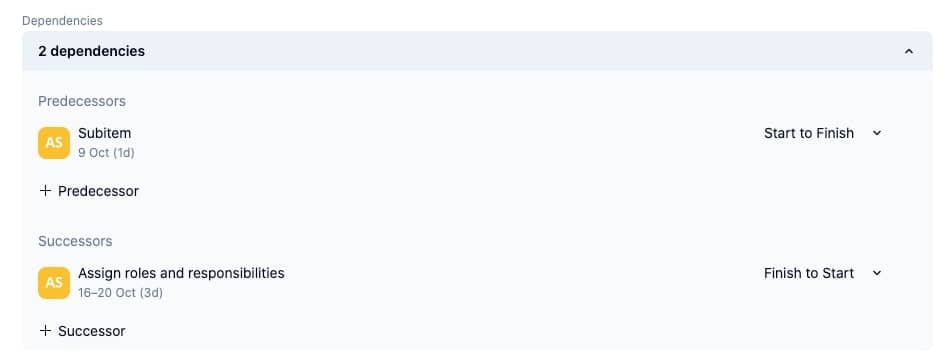
- Subtasks: Break larger tasks into smaller, manageable units with individual assignees and deadlines.
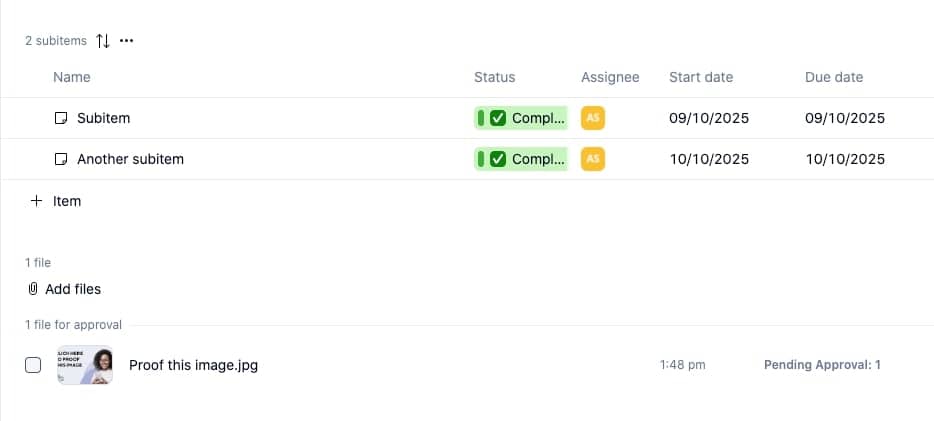
- Proofing and approvals: Streamlined review and feedback process for creative and client-facing deliverables.

- Comments: Real-time discussion threads on tasks with tagging for relevant stakeholders.
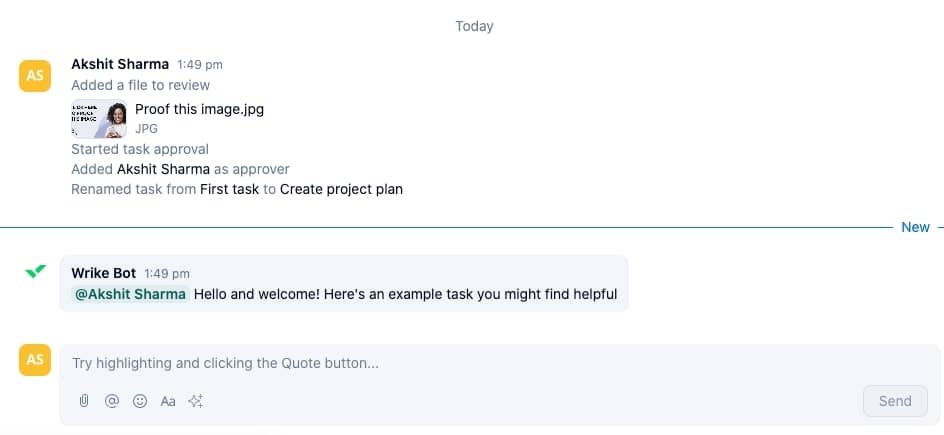
- Document sharing & versioning: Upload files, track changes, and maintain version history directly in the workspace.
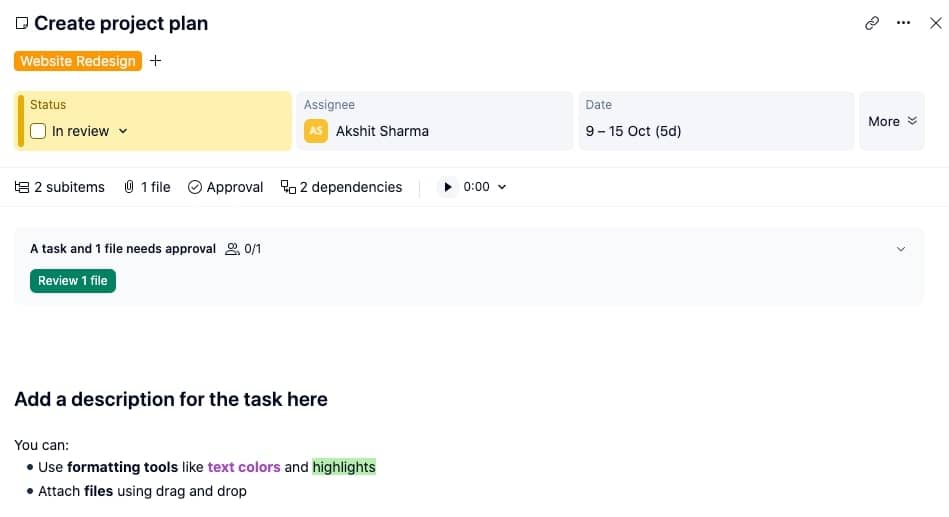
- Task prioritization: Set custom priorities and use filters to highlight critical work items.

- Automation rules: Automate repetitive actions such as task creation, status updates, or notifications.
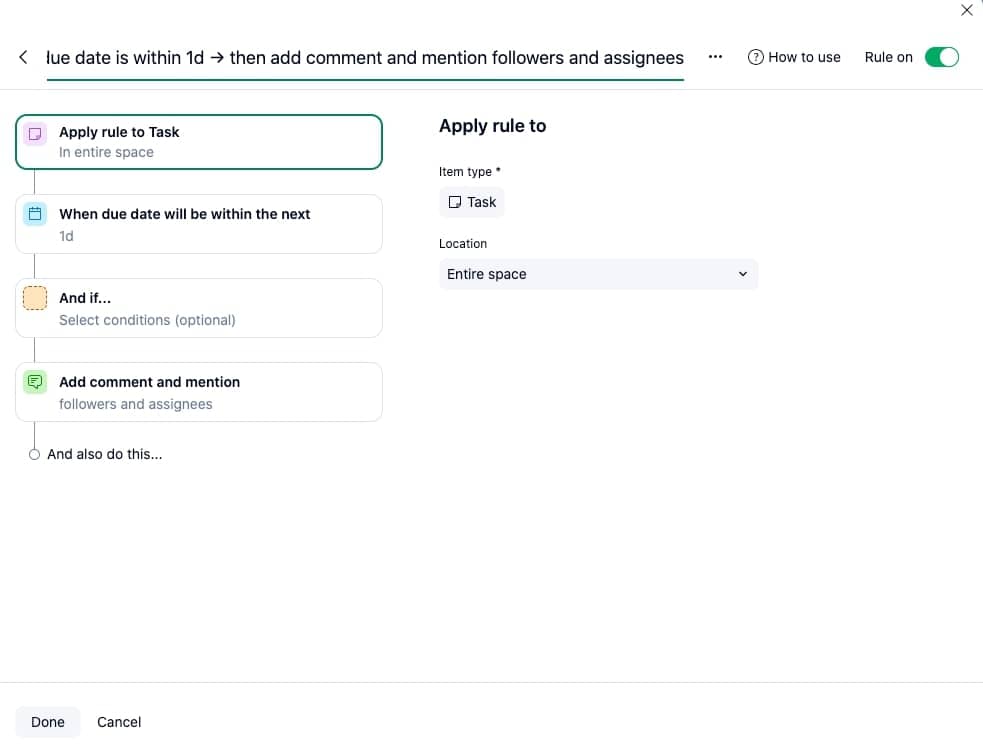
Wrike’s depth in task control and approval workflows makes it a favorite among professional services and enterprise teams that depend on precision, version control, and multi-step collaboration.
Asana’s task management and collaboration features
Asana takes a more human-centered and flexible approach to task management. It’s built to keep everyday collaboration simple – team members can see what’s due, comment inline, and track updates without wading through layers of configuration.
Where Wrike prioritizes structure, Asana emphasizes momentum. Tasks can be created and shared within seconds, helping teams move quickly while maintaining alignment. The tool’s clean design and communication-friendly layout make it ideal for creative, marketing, and cross-functional teams that value transparency and quick feedback loops.
Key task management and collaboration features in Asana include:
- Tasks and subtasks: Organize workloads and responsibilities with clear ownership and deadlines.
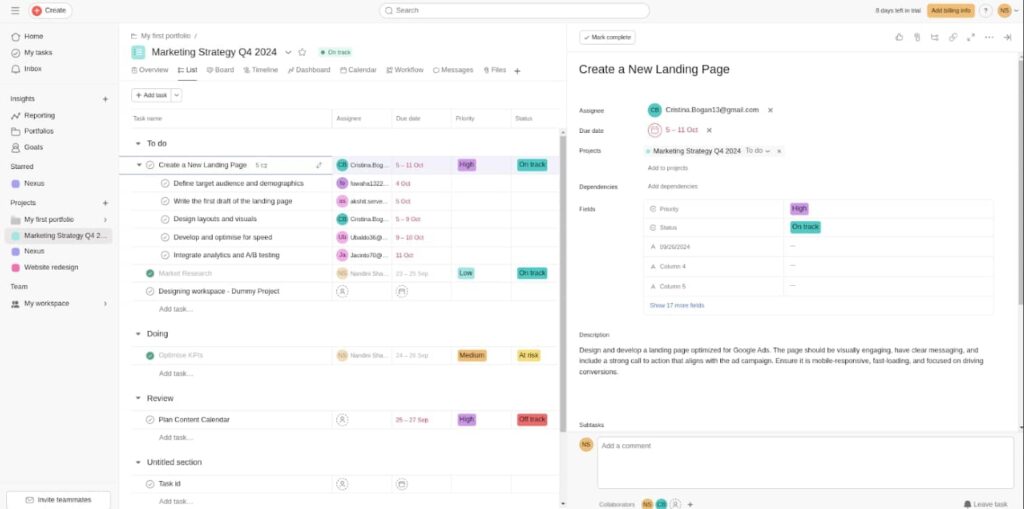
- Task comments & mentions: Centralized communication under each task – no more scattered email threads.
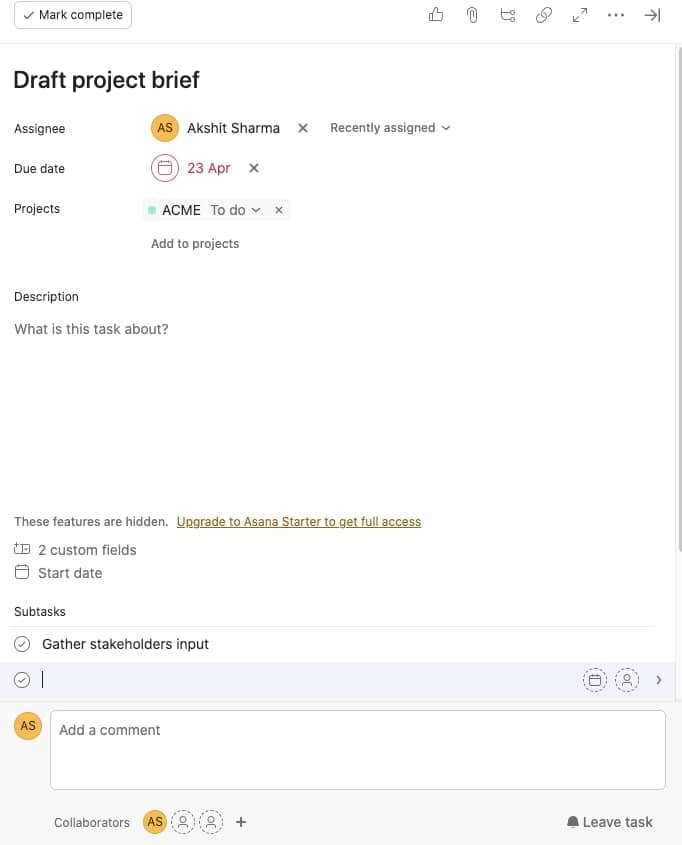
- Attachments & file previews: Upload and review documents, images, and media directly in Asana.
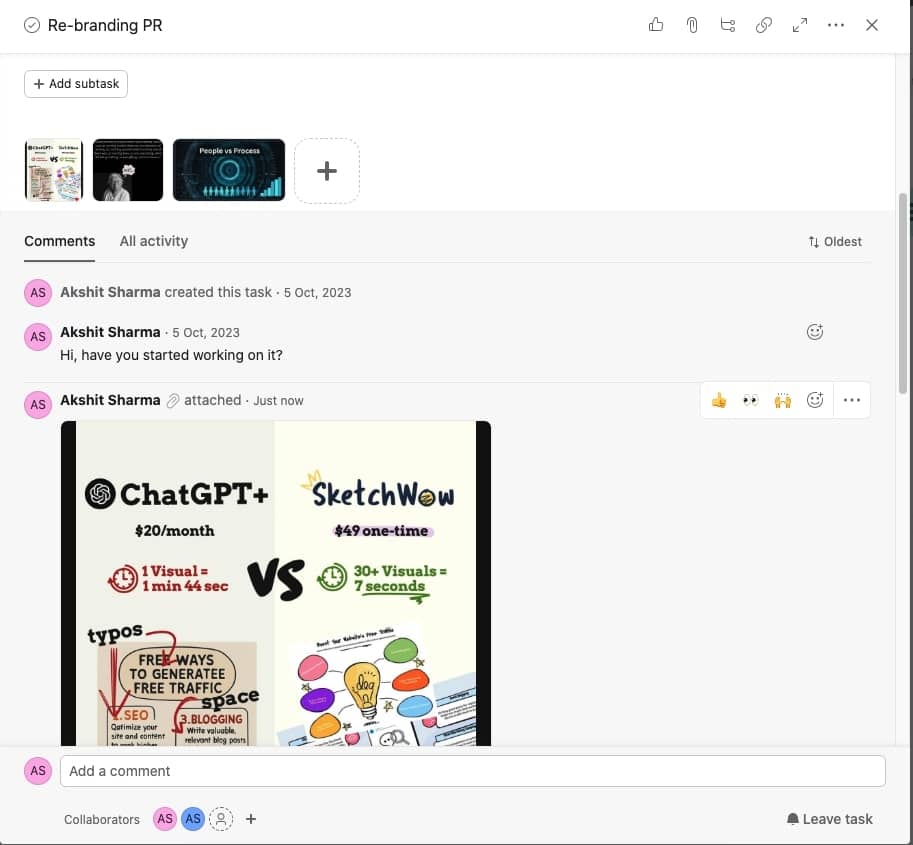
- Task dependencies: Dependencies communicate where the work is blocked, who is waiting, and get people notified when a predecessor task completes.
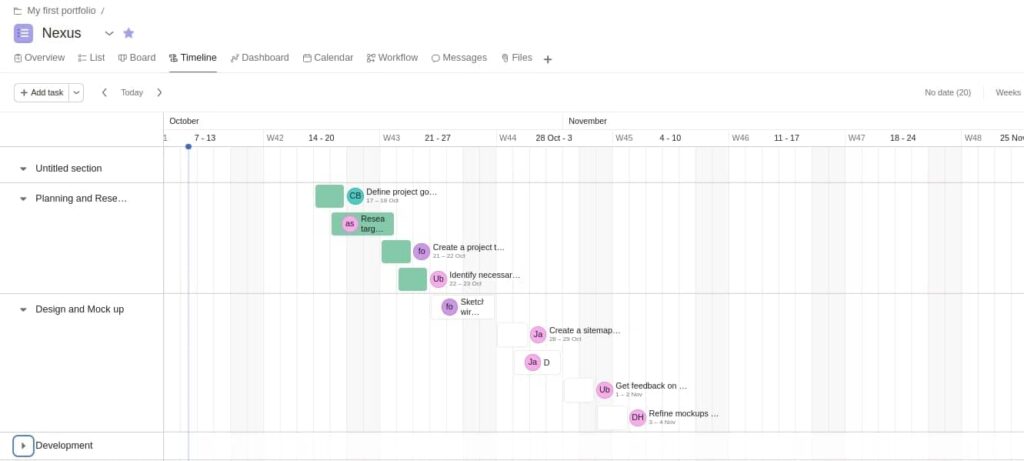
- Inbox notifications: Personal feed for real-time updates, mentions, and project changes.
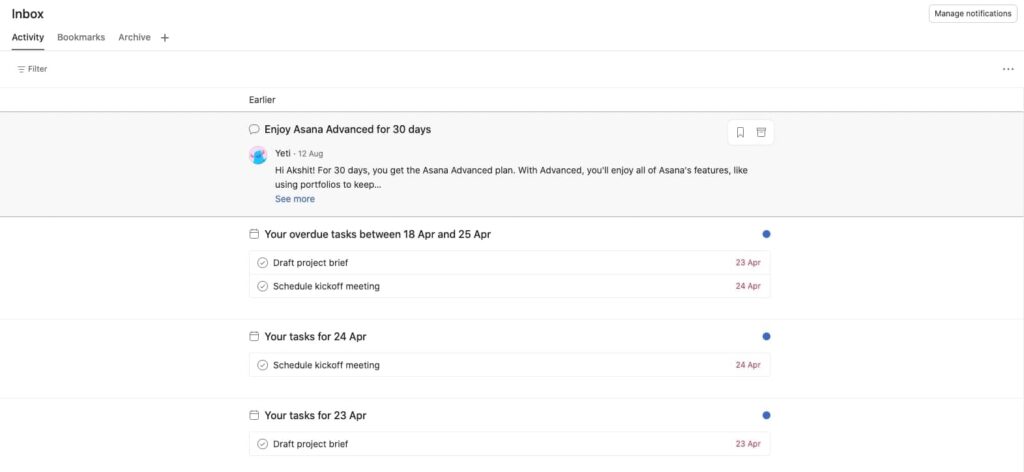
- Comment pinning: Pin important comments in a comment thread so that key updates or decisions stay visible to collaborators
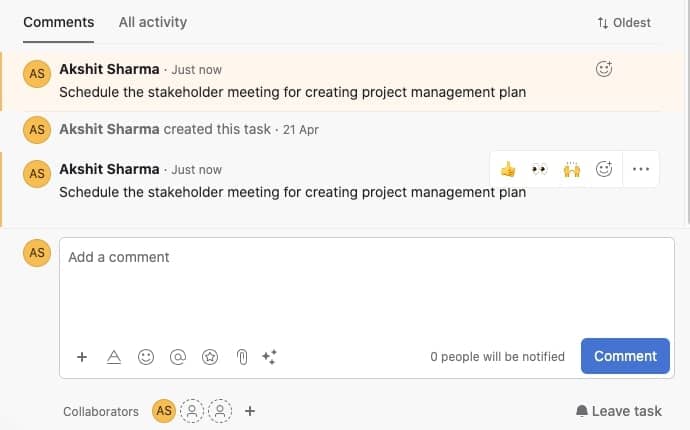
Asana keeps collaboration lightweight yet organized, ensuring that even fast-paced teams can stay in sync without unnecessary complexity.
ProofHub’s task management and collaboration features
ProofHub is built around the idea that effective task management and collaboration should happen in the same space. Instead of switching between chat apps, email threads, and file drives, teams can assign work, share updates, and exchange feedback directly within the project environment, keeping every piece of context in one place.
Where Wrike offers granular control and Asana emphasizes speed, ProofHub strikes a balance: it provides structure for complex projects while keeping everyday collaboration light and intuitive. Every task becomes a shared workspace where files, comments, time logs, and progress indicators stay together.
Key task management and collaboration features in ProofHub include:
- Task lists: Organize projects into detailed task lists, assign responsibilities, and break work into subtasks with individual deadlines and owners.

- Task dependencies: Establish clear relationships between tasks to visualize which items must be completed before others begin. Avoid blockers with critical path method.
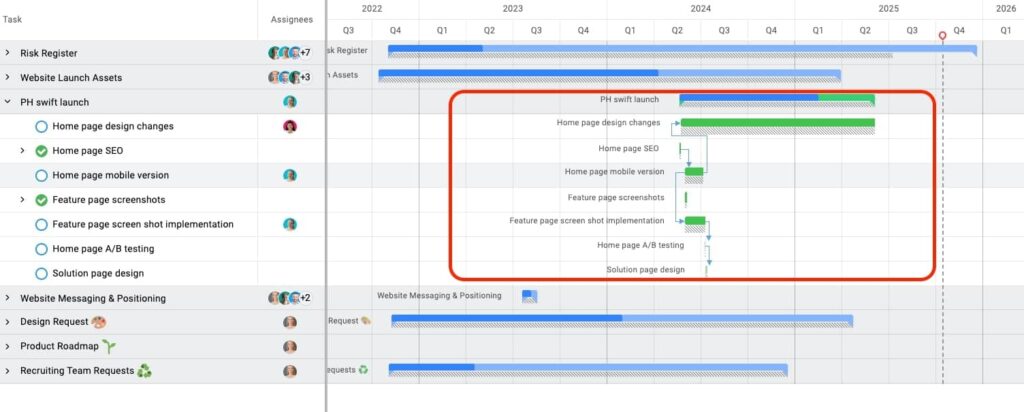
- Custom workflows: Define your own stages to reflect how your team actually works.
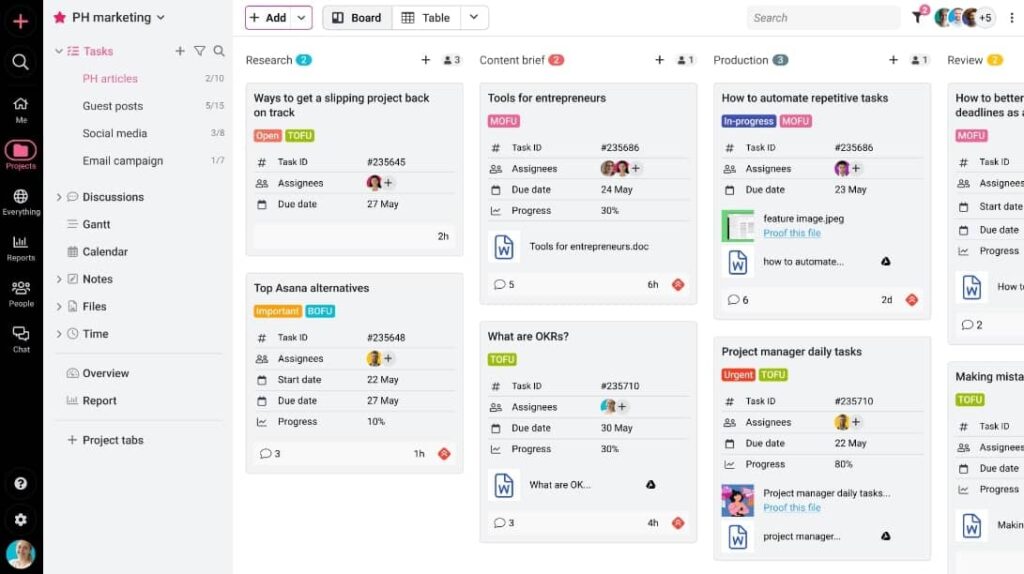
Comments & mentions: Keep discussions focused within tasks. Team members can mention colleagues, tag feedback, and maintain a single thread of conversation tied to each deliverable.
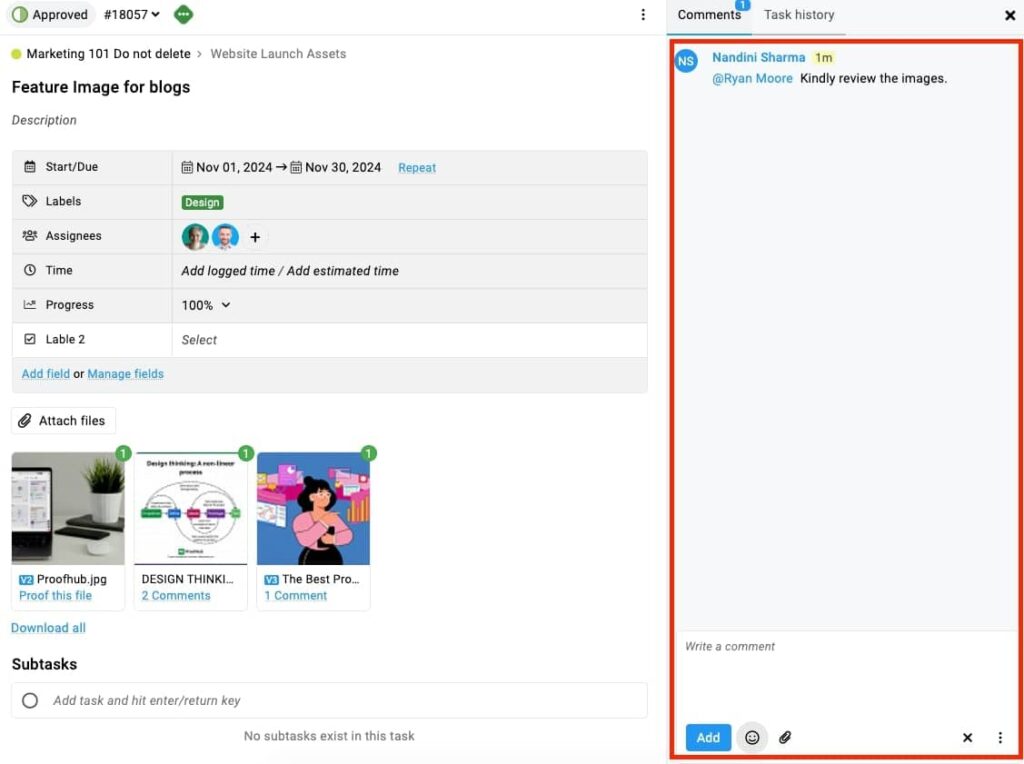
Proofing: Streamline creative reviews by annotating files, sharing feedback, and approving assets without using separate tools.
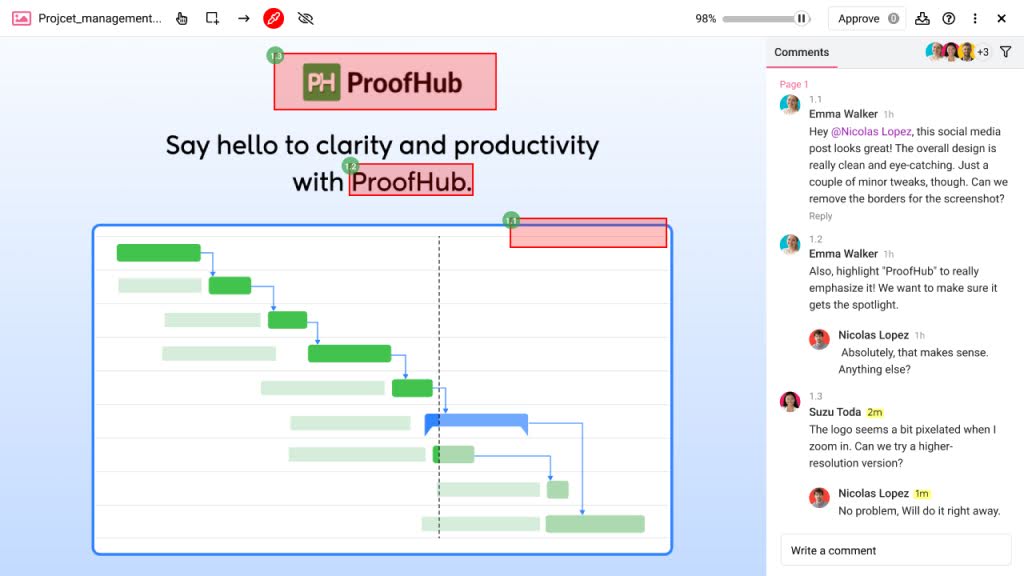
File sharing & version control: Upload and organize relevant files under each task, ensuring the latest versions are always accessible.
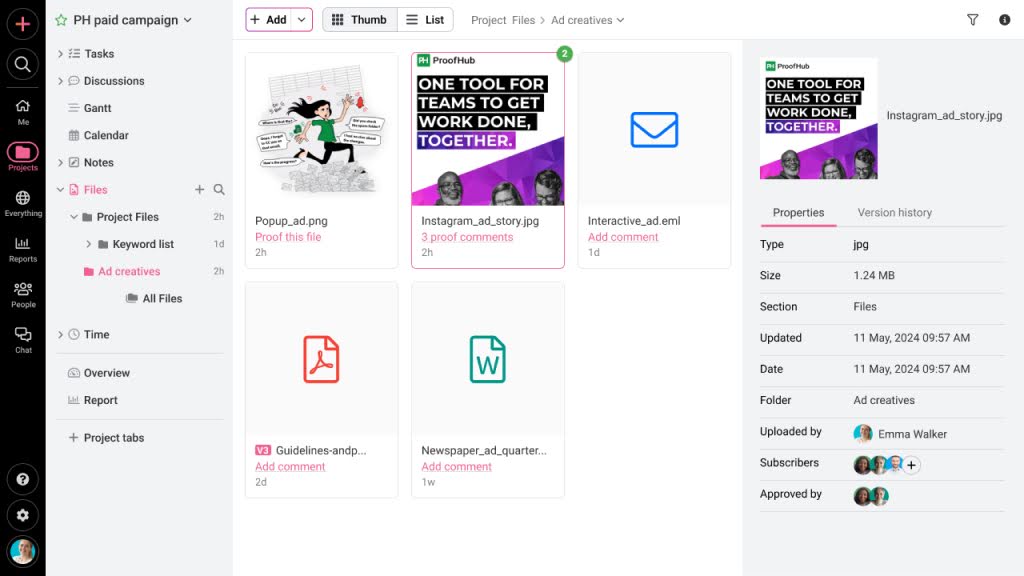
Chat: Built-in chat eliminates the need for external communication apps, keeping all exchanges discoverable and in context.

Task prioritization & labels: Categorize and prioritize work to focus attention on the most critical tasks each day.
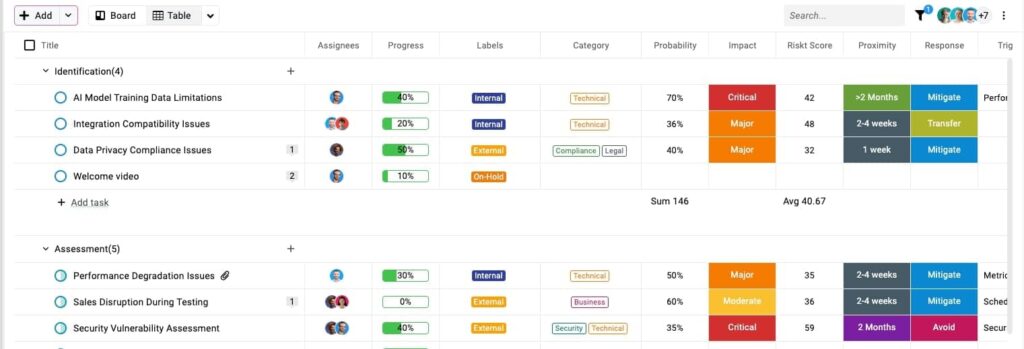
ProofHub’s collaborative model eliminates silos. Instead of creating more management overhead, it gives teams just enough process to stay organized while keeping communication natural. This makes it particularly effective for hybrid and cross-functional teams where clarity, feedback loops, and context continuity are essential.
With ProofHub, everyone – from designers and developers to project managers and clients – can stay connected in real time, ensuring that nothing slips through the cracks and no information is lost across tools.
Ease of use
No matter how powerful a project management tool is, it only succeeds if teams actually enjoy using it. Ease of use determines how quickly a tool is adopted, how efficiently teams complete daily work, and how little training managers need to provide. A platform that feels intuitive lowers resistance and boosts long-term engagement, while a complex interface can slow even the most experienced teams.
Wrike’s ease of use
Wrike’s usability reflects its enterprise-grade architecture – feature-rich, structured, and designed for precision. The interface offers enormous flexibility, but it demands time and intent to configure effectively. New users may find Wrike’s dashboard dense at first, especially when managing multiple projects or integrating custom workflows. However, once properly set up, the system becomes a central command center that provides unmatched visibility across teams and portfolios.
To mitigate the learning curve, Wrike includes guided onboarding and robust documentation, but it’s best suited for teams with dedicated project managers or administrators who can tailor the workspace to their processes. The payoff for this initial setup effort is a deeply integrated, insight-driven environment that rewards organized teams.
- Customizable interface: Rearrange dashboards, views, and fields to suit team workflows.
- Personalized home dashboard: Summarizes tasks, mentions, and upcoming deadlines in one view.
- Interactive gantt and board views: Visualize tasks dynamically and adjust timelines with drag-and-drop controls.
- Quick navigation bar: Access recent projects, folders, and tasks from a persistent left sidebar.
- In-App tutorials & help center: Step-by-step guides for setup, templates, and advanced configurations.
- Keyboard shortcuts & bulk actions: Accelerate routine management tasks with quick commands.
- Mobile apps (iOS & Android): Full-featured mobile experience for on-the-go project tracking.
Wrike’s learning curve can be steep, but once teams get accustomed to its layout and capabilities, it delivers a sense of control and operational clarity that simpler tools often can’t match.
Asana’s ease of use
Asana’s greatest strength lies in its effortless usability. Designed for immediate adoption, it requires almost no training to get started. Its clean interface, drag-and-drop simplicity, and visual layouts make it accessible to users of all technical backgrounds. Within minutes, teams can set up projects, assign tasks, and start collaborating – without needing to configure templates or workflows beforehand.
The design language emphasizes clarity over complexity, making it especially friendly for cross-functional teams and managers who prefer lightweight systems. Asana’s onboarding process feels natural – users learn features organically as they navigate through everyday tasks rather than through formal tutorials.
- Clean, minimal interface: Prioritizes readability and focus, with minimal clutter.
- Drag-and-drop task management: Instantly reorganize tasks, projects, and priorities.
- Quick add button: Create tasks or projects from anywhere with a single click.
- Color-coded projects: Visually distinguish teams, clients, or workflows at a glance.
- Smart suggestions: AI-assisted recommendations for task creation and due dates.
- Built-In onboarding guides: Inline prompts that introduce features as users need them.
- Universal search & filtering: Quickly locate tasks, people, or files across all projects.
- Mobile-friendly experience: Seamless mobile app for task updates, notifications, and approvals.
Asana’s ease of use makes it particularly appealing to teams that want speed, clarity, and immediate functionality, without needing extensive setup or training time.
ProofHub’s ease of use
ProofHub is designed with one clear principle in mind – a project management tool should make work simpler, not add to it. Its interface balances power with usability, allowing teams to get started quickly while still offering enough depth for structured project oversight.
Unlike Wrike, which often requires setup and administration, or Asana, which trades flexibility for ease, ProofHub brings an intuitive interface that’s ready to use yet customizable to fit any workflow. Teams can start managing projects within minutes, and as their processes mature, they can gradually add layers of structure without ever feeling constrained.
The design is clean, organized, and focused on visibility – all key factors that make it appealing to teams who want to reduce friction in daily work. Managers get clarity without digging through nested menus, and team members can find, update, and collaborate on tasks without needing constant training.
Key usability highlights in ProofHub include:
- Unified dashboard: A single, customizable home screen that summarizes all projects, tasks, discussions, and deadlines – keeping everyone on the same page.
- Simple onboarding: New users can start managing projects immediately without formal training or process mapping.
- Drag-and-drop interface: Move tasks, reorder priorities, and update stages across boards or Gantt views with ease.
- Minimal setup: Ready-to-use templates and workflows allow teams to create structure without complex configurations.
- Smart navigation: Persistent sidebar and universal search make it easy to locate tasks, files, and conversations instantly.
- Multi-view flexibility: Switch seamlessly between list, board, table, and calendar views depending on preference or project type.
- Clean design language: A distraction-free interface that focuses on content and clarity, even for large projects.
- Mobile accessibility: Full-featured mobile apps for iOS and Android let users manage work and approve updates on the go.
ProofHub’s strength lies in how natural it feels. Teams can focus on getting work done instead of figuring out how to make the software work for them. This balance between simplicity and structure ensures that adoption rates stay high across departments and roles.
For organizations tired of over-complicated systems or fragmented tool stacks, ProofHub’s ease of use offers a refreshing middle ground: a workspace that’s simple enough to start fast and strong enough to stay relevant as teams scale.
Scalability
As teams grow, so does the complexity of managing projects, people, and priorities. A scalable project management platform must not only support more users but also adapt to evolving workflows, security needs, and reporting demands. Scalability isn’t just about capacity – it’s about how gracefully a tool grows with your organization without forcing disruptive change.
Wrike’s approach
Wrike was built with scalability at its core. Its architecture supports multiple departments, global teams, and enterprise-level operations under one unified system. The platform allows organizations to create nested workspaces and custom permission structures, ensuring that as teams expand, each unit can maintain autonomy while remaining aligned with company-wide goals.
Wrike’s scalability is reinforced by its advanced resource management, analytics, and governance features. Large organizations can manage thousands of active projects, integrate third-party applications, and control data access through granular admin rights. Its modular pricing also lets enterprises start small and unlock more advanced capabilities – like automation, custom reporting, and integration APIs – as they grow.
Scalability-oriented features in Wrike include:
- Folder & space hierarchies: Structure projects by department, client, or region with flexible nesting.
- Enterprise admin controls: Manage access, permissions, and roles at scale with detailed governance.
- Wrike integrates & API access: Automate data exchange between CRMs, HR tools, and ERP systems.
- Custom user groups: Segment users by team or function to simplify administration.
- Advanced reporting & dashboards: Real-time insights across portfolios, programs, and departments.
- Workload & resource planning: Balance team capacity across large-scale operations.
- Security & compliance: Support for SSO, SCIM, SOC 2, GDPR, and audit trails for enterprise assurance.
- Flexible pricing tiers: Scale functionality and seat count progressively without migration.
Wrike’s depth makes it ideal for mature organizations or those expecting rapid growth, where scalability means control, compliance, and sustainable expansion.
Asana’s approach
Asana’s scalability focuses on ease of expansion rather than administrative depth. Its intuitive setup allows small teams to start fast and gradually add structure as they grow. For many organizations, Asana serves as a bridge between informal task tracking and formalized project governance – offering a smooth path to scalability without the rigidity of enterprise tools.
Asana supports larger teams through its portfolios, goals, and reporting modules, which link day-to-day work to strategic outcomes. However, as organizations grow more complex – especially those requiring detailed permissions or multiple workspace hierarchies – Asana may need supplementary integrations or higher-tier plans to maintain control and visibility.
Scalability-oriented features in Asana include:
- Portfolios: Group and monitor multiple projects for visibility across teams.
- Goals and milestones: Connect company objectives with project-level execution.
- Workspaces and teams: Organize users into structured groups for clarity as teams expand.
- Admin console: Manage user access, billing, and team permissions centrally.
- Advanced search & reporting: Track performance metrics across departments and timeframes.
- Automation rules: Simplify scaling by reducing repetitive manual actions.
- Enterprise security: SSO, data encryption, and admin controls available on higher-tier plans.
- Integrations with growth tools: Connects seamlessly with apps like Slack, Salesforce, and Microsoft Teams.
Asana’s scalability shines for growing SMBs and mid-sized organizations that need an approachable platform capable of evolving as their processes mature – without overwhelming their teams.
ProofHub’s approach
ProofHub is built to scale without complexity. Whether you’re managing a small creative team or coordinating projects across departments, the platform adapts to your growth naturally – without forcing you to change how you work or pay exponentially more as you add people.
Where Wrike focuses on enterprise-grade configurability and Asana emphasizes ease for growing SMBs, ProofHub bridges both worlds. It offers the governance and control needed for expansion, while keeping the user experience simple and consistent. Its flat pricing model (no per-user fees) makes scaling operationally and financially predictable – a major advantage as teams grow or bring in external collaborators.
Scalability in ProofHub isn’t just about accommodating more users; it’s about supporting more complexity – multiple projects, hierarchies, permissions, and reporting layers – without creating administrative overhead.
Scalability-oriented features in ProofHub include:
- Flat pricing model: A single subscription covers unlimited users, ensuring that scaling teams don’t face escalating costs as they grow.
- Custom roles & permissions: Create granular access levels for different teams, departments, or clients, ensuring data security and clarity of responsibility.
- Multiple project management methodologies: ProofHub supports Agile, Waterfall, and hybrid workflows, letting organizations evolve their work style as they mature.
- Centralized project hierarchies: Manage multiple projects, portfolios, and departments from one unified workspace with consistent visibility.
- Advanced reports: Gain real-time insights into productivity, workloads, and project health at both micro and macro levels.
- Global workload view: See who’s working on what, identify capacity gaps, and balance workloads across projects effortlessly.
- Custom fields: Tailor the platform to specific processes, departments, or clients – without the need for IT involvement.
- Robust security & data control: Features like IP restrictions, SSL encryption, and activity logs support data integrity and governance for growing teams.
- Client access management: Add clients or external partners to the workspace with controlled visibility and participation settings.
ProofHub’s approach to scalability is inclusive and sustainable. It doesn’t require organizations to buy additional modules, manage multiple workspaces, or invest in expensive add-ons. As your team expands, the same structure – tasks, workflows, discussions, and reports – simply scales with it.
This makes ProofHub ideal for organizations that want to grow without fragmenting their systems. Whether you’re adding five users or five hundred, the experience remains consistent – predictable, secure, and adaptable.
Pricing
Wrike’s pricing
Wrike has five plans:
- Free: $0 per user per month, for teams getting started
- Team: $10 per user per month, for small teams
- Business: $25 per user per month, for all teams across an organization
- Enterprise: Contact sales for large teams
- Pinnacle: Contact sales for teams with complex work needs
The biggest quirk of Wrike’s pricing structure is that most of the useful features are reserved for top-tier plans. Even the Team plan, which costs $10 per user per month, does not have core features: File proofing & approval, Time Tracking, Reports, Request forms, and Task & project approval; let alone the Advanced analytics, Workload chart, and Advanced security.
If you are choosing Wrike for these features, keep in mind that you have to sign up for the Business plan. Even in the business plan, there are limitations. It does not come with advanced analytics, and it has an automation limit of 200 per seat per month. There are chances you have to switch to the enterprise plan of Wrike.
Asana’s pricing
Asana uses a five-tier pricing model that looks simple but has meaningful cost and planning implications:
- Personal – Free for up to 10 users; suited for individuals or very small teams.
- Starter – $10.99/user/month (annual) or $13.49 (monthly), 2-seat minimum; for growing teams.
- Advanced – $24.99/user/month (annual) or $30.49 (monthly), 3-seat minimum; for cross-functional departments.
- Enterprise – Custom pricing, 5+ seats; for large organizations needing advanced security and admin controls.
- Enterprise+ – Custom pricing; for regulated industries with strict compliance requirements.
While the per-user pricing is competitive, the real cost of ownership extends beyond subscriptions. Minimum seat requirements add overhead, and non-transferable licenses can lead to duplicate charges across workspaces.
For most teams, budgeting an extra 25–40% above base pricing is realistic once operational and change-management expenses are factored in.
Asana is a worthwhile investment when cross-functional collaboration is central to your workflow, but buyers should weigh these hidden costs carefully against alternatives that offer more predictable pricing.
ProofHub’s pricing
ProofHub’s pricing model is built around one simple idea: growth shouldn’t come with penalties. Instead of charging per user, ProofHub offers a flat, fixed-rate pricing structure that lets organizations add as many users as they need without worrying about rising subscription costs.
This approach stands in sharp contrast to Wrike and Asana, whose per-user models can quickly become expensive as teams scale. For fast-growing organizations, agencies, and cross-functional teams, ProofHub’s transparent pricing ensures budgeting is predictable and sustainable – no matter how many people or projects are onboarded.
ProofHub offers two straightforward plans designed for teams of all sizes:
- Essential plan – Flat $45/month (billed annually) for unlimited users
- Ultimate control plan – Flat $89/month (billed annually) for unlimited users
Both plans support all the core features and come with no hidden fees, add-on charges, or per-seat upgrades. The flat monthly or annual billing makes it easier for finance teams to forecast costs and prevents surprise expenses tied to growth or turnover.
Which tool is best for your team?
Both tools offer powerful functionality, but they’re designed for different types of organizations and management philosophies. Below, we break down which platform fits best depending on how your team operates.
1. Team size & workstyle
Wrike caters best to large, structured organizations that manage multiple teams, clients, or departments under one umbrella. Its customizable dashboards, layered permissions, and detailed analytics suit leaders who need visibility across complex operations. Teams that value consistency, reporting precision, and workflow automation will find Wrike’s scalability a long-term advantage.
In contrast, Asana is designed for fast-moving, collaborative teams that prefer minimal setup and quick execution. Its intuitive interface and flexible views make it perfect for marketing teams, startups, or creative groups where priorities often shift, and collaboration happens in real time. Asana’s simplicity allows individuals to stay productive without needing a dedicated administrator or project manager.
2. Use cases – Marketing, agency, enterprise, SMB
Each platform aligns differently depending on the nature of the organization and its workflow needs:
- Marketing teams: Asana excels for marketing teams running campaigns, social calendars, or content workflows. Its templates, automation, and visual views support clear communication and creative progress tracking. Wrike, on the other hand, offers superior asset proofing, version control, and campaign performance tracking for larger marketing operations.
- Agencies & client-facing teams: Wrike’s proofing tools, client access controls, and customizable reports make it a strong fit for agencies managing multiple accounts. Asana can still serve smaller agencies well, but Wrike’s detailed reporting and approval chains cater better to external stakeholders.
- Enterprises: Wrike is purpose-built for enterprise environments that need governance, multi-level access, and system integrations with tools like Salesforce or Microsoft Teams. Asana can handle larger teams, too, but its simplicity becomes limiting at enterprise scale.
- Small and medium businesses (SMBs): Asana provides everything an SMB needs – task management, basic automation, reporting, and integrations – in an affordable, easy-to-learn interface. Wrike may feel overpowered for smaller teams unless they anticipate rapid scaling.
3. Cost-effectiveness & pricing models
Both Wrike and Asana follow a tiered, per-user pricing model, but their value depends on how your team scales and which features you need.
- Wrike pricing: Offers a limited free plan and several paid tiers (Team, Business, Enterprise, and Pinnacle). The pricing escalates based on user count and advanced needs such as analytics, automation, or integration depth. Wrike’s cost is justified for teams leveraging enterprise-grade governance, custom workflows, and analytics, but it can be expensive for small teams using only basic features.
- Asana pricing: Also follows a freemium model, with a robust free plan suitable for individuals or small teams. Its paid tiers (Starter, Advanced, and Enterprise) unlock automation, timelines, reporting, and admin controls. Asana delivers strong ROI for SMBs by offering balanced functionality at a lower entry cost.
4. Pros and Cons
Here’s a snapshot of how both tools compare in strengths and limitations:
Wrike
Pros
- Enterprise-grade customization and control
- Advanced analytics and reporting
- Strong proofing and approval workflows
- Scalable structure for large teams
Cons
- Steeper learning curve
- Overwhelming for small teams
- Higher cost at scale
Asana
Pros
- Simple and intuitive interface
- Fast onboarding
- Several collaboration and visualization tools
- Affordable for small to medium teams
Cons
- Limited customization
- Fewer advanced analytics and governance tools
- Can feel restrictive for enterprise-level workflows
ProofHub for different team types and use cases
Both Wrike and Asana cater to specific audiences – Wrike to structured enterprise teams and Asana to agile, fast-moving ones. ProofHub, however, bridges that gap. It’s built for teams that want simplicity in everyday collaboration but also need the structure and governance to manage complex projects at scale.
By combining centralized project control, flexible workflows, and predictable pricing, ProofHub works equally well for small startups, creative agencies, growing SMBs, and large cross-functional enterprises. Its strength lies in adaptability – teams can shape it around their work instead of reshaping their work to fit the tool.
Team size & workstyle
- Small teams and startups: ProofHub helps small teams get organized fast. It’s an all-in-one workspace that eliminates the need for multiple tools, making it easy to plan, communicate, and deliver projects without tech overhead.
- Mid-sized businesses (SMBs): As operations grow, ProofHub provides the visibility and structure needed to manage multiple projects simultaneously – without introducing administrative complexity or cost escalation.
- Large organizations and enterprises: With granular permissions, advanced reporting, and scalable project hierarchies, ProofHub gives enterprise teams the control they need while keeping the user experience simple enough for broad adoption.
Use Cases – Marketing, agency, enterprise, SMB
- Marketing teams: ProofHub’s Kanban boards, Gantt charts, and proofing tools make it ideal for managing campaign calendars, creative reviews, and content approvals in one place. Marketing teams can easily track campaign progress and maintain brand consistency without bouncing between tools.
- Agencies & client-facing teams: Built-in proofing and approval workflows simplify client feedback cycles. Agencies can give clients controlled access to projects, share deliverables, and capture feedback directly on files – reducing delays and miscommunication.
- Product & engineering teams: ProofHub supports iterative development cycles with custom workflows and milestone tracking. Teams can plan sprints, manage backlogs, and align releases with strategic goals while maintaining full visibility across dependencies.
- Cross-Functional & remote teams: With discussions, chat, and integrated project visibility, remote and hybrid teams can collaborate as if they were in the same room. ProofHub keeps communication centralized and context-driven, ensuring distributed teams remain aligned.
- Enterprises: For organizations managing multiple departments and projects, ProofHub’s centralized hierarchy and advanced access controls help enforce governance while preserving collaboration. It scales seamlessly with team size and operational complexity.
ProofHub adapts to teams’ natural work rhythms. It doesn’t demand rigid adoption of predefined structures or excessive training. This flexibility allows teams across different industries – from creative agencies to IT departments – to create their own systems within a single, unified workspace.
Frequently asked questions
What advanced reporting and analytics features does Wrike offer compared to Asana?
Wrike provides customizable dashboards, portfolio reporting, and analytics through its Wrike Analyze module, allowing advanced data visualization and performance tracking. Asana offers standard progress reports and goal tracking, but lacks Wrike’s deep, BI-style analytical customization.
How do Wrike and Asana handle task prioritization and dependencies?
Both tools support task dependencies and prioritization. Wrike offers more structured dependency mapping and critical path analysis, while Asana provides simple visual task linking suitable for everyday project tracking and smaller teams.
Which tool is more cost-effective: Wrike or Asana?
Asana offers better value for small to mid-sized teams with its robust free plan and affordable pricing tiers. Wrike, though more expensive, is cost-effective for large enterprises that need advanced customization, governance, and reporting.
Is there a free plan, and what are the usage limits?
Yes. Both Wrike and Asana offer free plans. Asana’s free tier supports up to 15 users with basic task views, while Wrike’s free plan is suitable for smaller teams but limits access to advanced features like analytics and automation.
What are the top integrations for Wrike and Asana?
Wrike integrates with tools like Salesforce, Microsoft Teams, and Adobe Creative Cloud, making it ideal for enterprise ecosystems. Asana connects seamlessly with Slack, Zoom, Google Workspace, and Miro – perfect for collaborative and creative workflows.
Which is better: Wrike or Asana?
It depends on your team’s needs. Wrike is better for large, structured teams needing advanced customization, reporting, and enterprise control. Asana excels for small to mid-sized teams wanting simplicity, quick onboarding, and seamless collaboration.
Is Wrike cheaper than Asana?
Not usually. Asana’s pricing starts lower and offers strong functionality in its free and mid-tier plans. Wrike becomes cost-effective for enterprises using its advanced automation, analytics, and integration capabilities.
